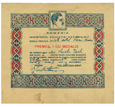The first certification of the area is from the years 1522-1523, when Prince Radu of Afumati gave into possession an important area "To Neagu with his brothers and his sons" (Documents on the History of Romania, the sixteenth century, the Romanian Country B. Volume I - ed. Academiei RPR), the town is mentioned as "Bisovca"
In the sixteenth and seventeenth centuries on the current boundary of Bisoca, there were mansion properties, monasteries, as well as free men.
In the absence of documents from the first two centuries of its existence it is not known precisely what was the area of Bisoca, but at the end of sec. XVIII, in the general work of F.C. Bouer, Bisseika (Bisoca) belonged to Buzau county, appearing as a hamlet and a note that settlement was abandoned.
Also, in a map of the 1700 from Constantine Cantacuzinos' great-grandfather, on the current boundary there is no settlement. The settlement occurs only in an Austrian map of Spicht Olwist in the years 1790-1791 under the title "Biszonca" and in a Russian map from 1835, Bisoca appears as "Biseveca" together with two adjacent villages.
Only in 1864, in a map and in the "gazetteer of Romania" by George Lahovari from 1898, there are 7 of the 9 villages of the commune.
The head of the family (who built the cottage himself), fought in the World War One and later on, was also part of the Anti-communist Resistance.
The anti-communist struggle in Romania began soon after the World War Two. In Vrancea, the historical data show that there were six resistance groups that fought in the Vrancea Mountains for almost 18 years. The most important of them is the "Vrancea Group" lead by the Paragina brothers (Cristea and Ion)
As the capture of the people in the resistance took many years, Securitatea organized real theatrical moves transforming their agents into tourists, drivers, shepherds, woodsmen or even in false partisans. They were often desconspired by the true fighters. Sometimes the security infiltrated the monasteries at the base of the mountains, being well know that sometimes the resistance soldiers used to hide in such places.
There were times where such infiltrations were not necessary since the priests were asked to freely collaborate with the security. It is also known that there were still many monks and priests that kept on helping the fugitives.






















